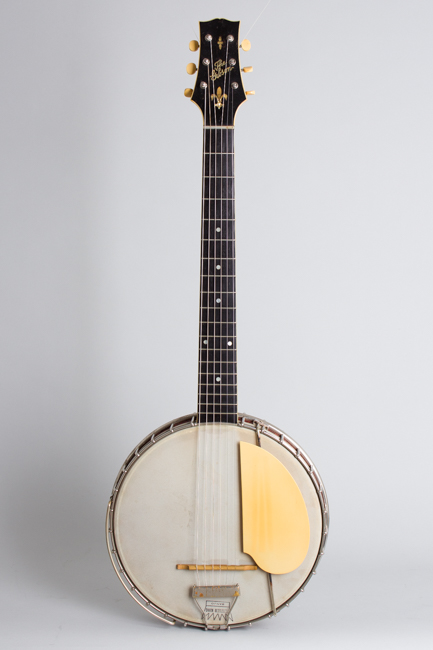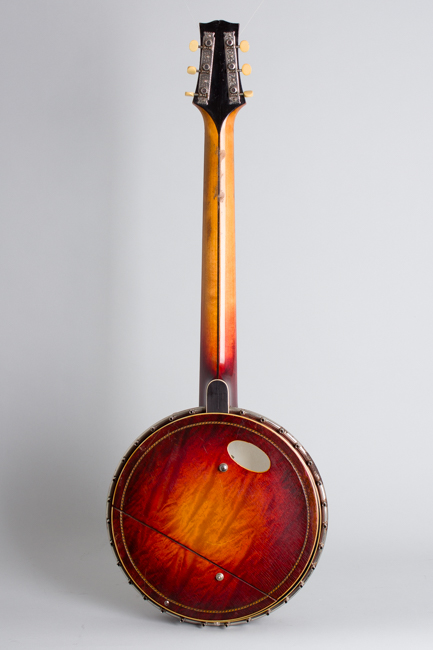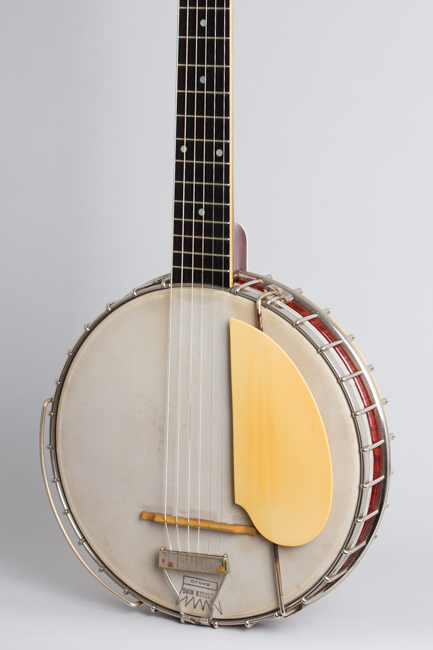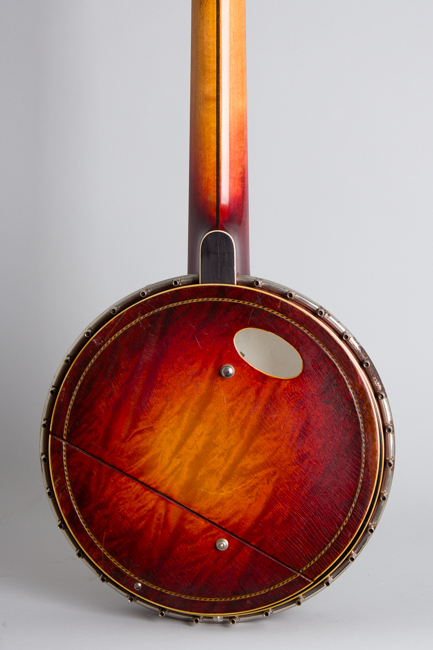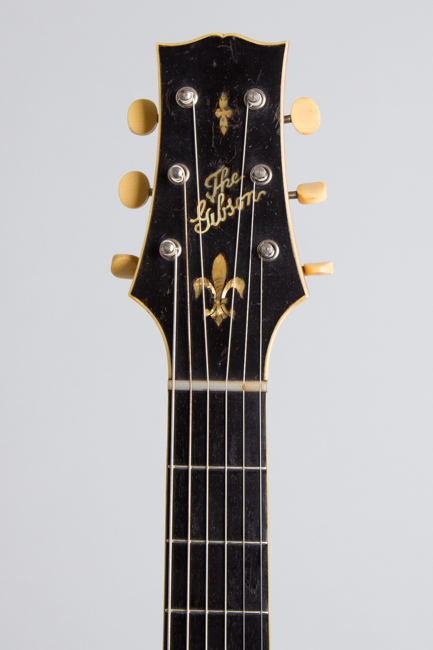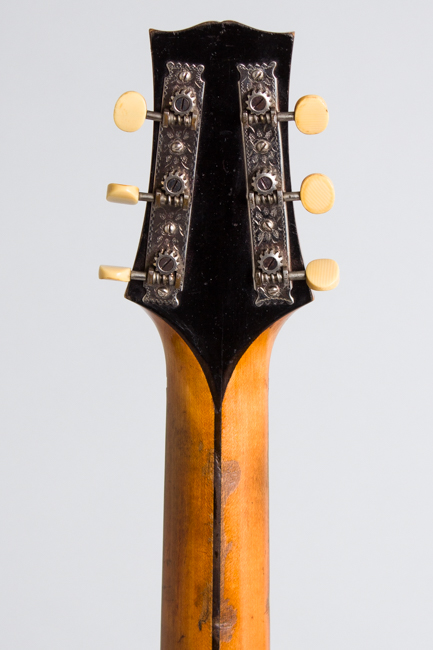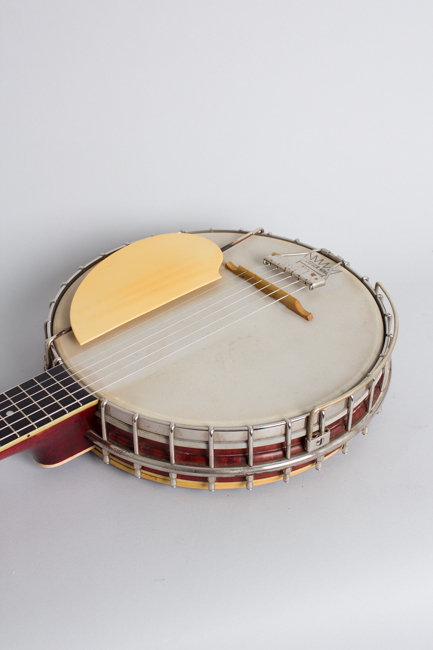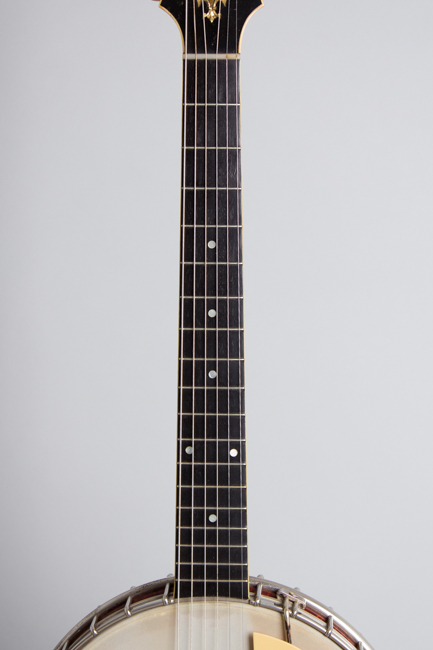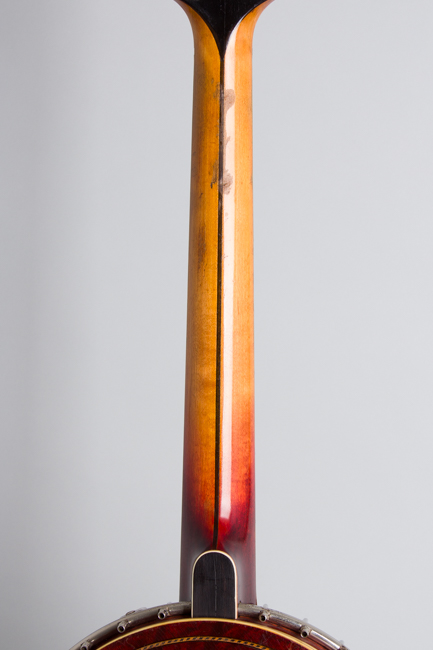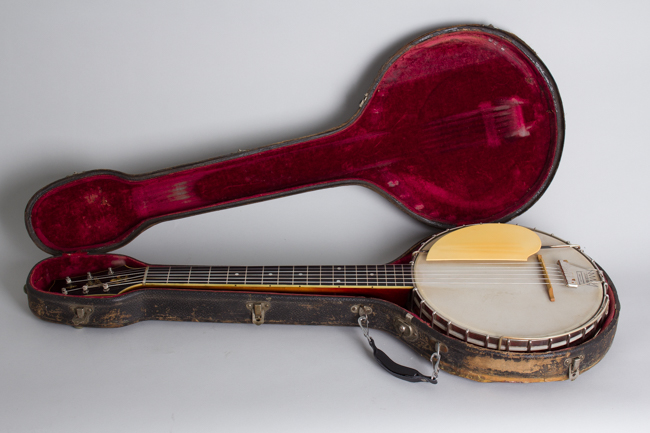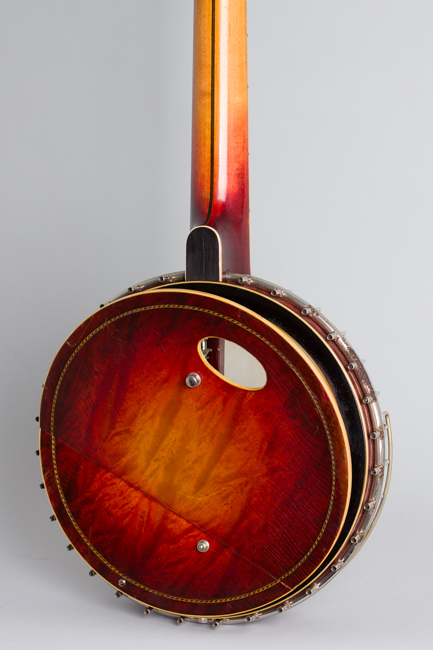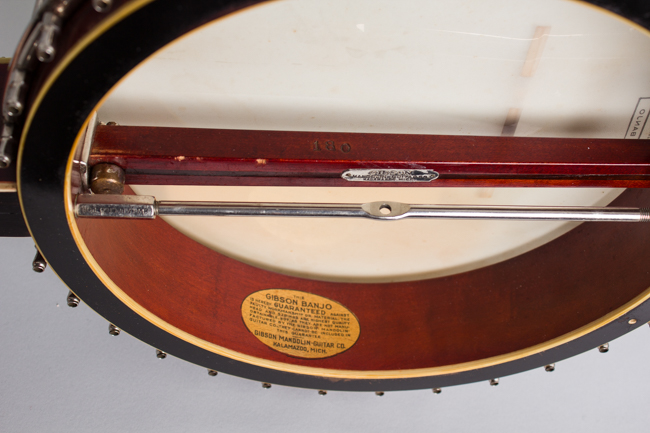Gibson Style GB Guitar Banjo (1919)
This item has been sold.
Item # 11841
Prices subject to change without notice.
Gibson Style GB Model Guitar Banjo (1919), made in Kalamazoo, Michigan, sunburst varnish finish, laminated maple rim and neck, ebony fingerboard, original black hard shell case.
This over 100-year-old creation is a super early and very interesting example of one of Gibson's more unusual instruments, the "Style GB" banjo-guitar. This is one of the very first "Style GB" banjo/guitars ever made, and has several major differences from nearly all other production models, notable a smaller rim and different headstock design. Even more unusual, it appears to have either gone back to the factory a couple of years after construction, or (knowing how things often went as Gibson) was held in stock for a couple of years, and when finally sold fitted out with more contemporary hard ware. In either case this is a seriously rare, possibly unique variant.
The "Style GB" was part of Gibson's initial banjo line, introduced in 1919 as follow-ups to the original "Style TB" tenor banjo which debuted in 1918. There were numerous variations of these instruments created over the next several years as Gibson continually experimented, trying to create a banjo line sonically on par with their mandolins and guitars. The "GB" banjo-guitar is not the rarest model in this pre-Mastertone line but now in the 21st century the most popular.
This first-generation "GB" has a smaller 12" rim than familiar version used by Papa Charlie Jackson, which was built on a huge 14" rim; this is the only one like it we have ever seen. Like all the earliest Gibson banjos it carries a traditional wooden dowel stick, with the serial number 180 stamped into it and a small metal Gibson logo plate inset. The early rim is constructed as a double-walled wooden honeycomb with hollow tone chambers, ebony capped and bound inside and out on the bottom.
This 1919 "GB" pre-dates the introduction of "trapdoor" hinged plate resonator and the company's co-ordinator rod by a year or two but is fitted with both. It also has the floating celluloid pickguard and wire armrest, both optional features in the early 1920s. As noted the instrument was either re-worked at the factory a couple of years after completion, or quite likely an early sample held in stock for some time and fitted out with all the "modern" (1922) hardware before finally shipping out. As a result it is even more deluxe (and functional!) than as originally designed. Whatever the story, all of this is Gibson factory work.
These early Gibson banjos were quite expensive instruments when new, and the construction and cosmetics are rather upscale. The neck is laminated maple with an ebony center strip, finished in a graduated cherry-to-natural from the heel up. Both the extended ebony fingerboard and headstock are bound. These usually have a unique more rounded "moccasin head" headstock design, but this one has a more angular "snakehead" shared with the very first "TB" models. This is faced with ebony inlaid with a pearl "The Gibson" logo and fleur-de-lis. The tuner buttons are amber celluloid and the nut is genuine pearl.
With the smaller 12" rim, this early "GB" also sounds quite unique, not quite as dark-toned as later models, but still less bright and piercing than most 6-string banjos. This is actually quite a useful banjo-guitar; it plays very well and sounds not quite like either instrument, exactly, but has a sort of ethereal plunk that sounds as if it is coming from somewhere long ago and far away!
Overall length is 35 1/2 in. (90.2 cm.), 12 in. (30.5 cm.) diameter head, and 2 5/8 in. (6.7 cm.) in depth, measured at side of rim. Scale length is 25 in. (635 mm.). Width of nut is 1 3/4 in. (44 mm.).
This possibly unique banjo remains very original now well past its 100th birthday. Overall it shows some typical wear, mostly spots worn through the finish on the back of the neck, scratching/scuffing to the headstock and heavy varnish checking and scratching to the resonator back. The back of the neck has some shallow capo dinks in the lower positions. There are no cracks or structural damage except a repaired lamination split at the tail end of the dowel and a small sealed grain split on the heelcap.
The hardware appears all original including the tuners, oft-missing tailpiece and a full set of the unique early Gibson hooks and nuts. The tailpiece was re-worked long ago to string thru rather than over the bar, making for a better break angle to the bridge. Most of the plating is in good shape but the upper side of the bearing tube and tailpiece crossbar show some noticeable plating wear. The banjo was fitted with an early Remo Weather King plastic head generations ago, which is still holding up well. A small extra thin metal plate has been added over the base of the tailpiece to help secure it (this hook-on design does not work well with a plastic head) but this did not involve any modification to the instrument itself.
The banjo is set up with a carved wood bridge and silk-and-steel strings. The fingerboard and original frets show light wear but nothing that impedes play, and this is simply a very fun instrument to plunk away on. The flat plate "trapdoor" resonator works perfectly "enhancing the banjo piquancy" Gibson claimed, in reality acting as a convenient monitor for the player, since it basically lets the sound flow right at your face! This extremely rare variation is also a very nice gigging instrument, somewhat easier to handle than the standard 14" rim version of these somewhat finicky large rim banjos. It still resides in the very battered but functional red-lined OHSC. Excellent - Condition.
This over 100-year-old creation is a super early and very interesting example of one of Gibson's more unusual instruments, the "Style GB" banjo-guitar. This is one of the very first "Style GB" banjo/guitars ever made, and has several major differences from nearly all other production models, notable a smaller rim and different headstock design. Even more unusual, it appears to have either gone back to the factory a couple of years after construction, or (knowing how things often went as Gibson) was held in stock for a couple of years, and when finally sold fitted out with more contemporary hard ware. In either case this is a seriously rare, possibly unique variant.
The "Style GB" was part of Gibson's initial banjo line, introduced in 1919 as follow-ups to the original "Style TB" tenor banjo which debuted in 1918. There were numerous variations of these instruments created over the next several years as Gibson continually experimented, trying to create a banjo line sonically on par with their mandolins and guitars. The "GB" banjo-guitar is not the rarest model in this pre-Mastertone line but now in the 21st century the most popular.
This first-generation "GB" has a smaller 12" rim than familiar version used by Papa Charlie Jackson, which was built on a huge 14" rim; this is the only one like it we have ever seen. Like all the earliest Gibson banjos it carries a traditional wooden dowel stick, with the serial number 180 stamped into it and a small metal Gibson logo plate inset. The early rim is constructed as a double-walled wooden honeycomb with hollow tone chambers, ebony capped and bound inside and out on the bottom.
This 1919 "GB" pre-dates the introduction of "trapdoor" hinged plate resonator and the company's co-ordinator rod by a year or two but is fitted with both. It also has the floating celluloid pickguard and wire armrest, both optional features in the early 1920s. As noted the instrument was either re-worked at the factory a couple of years after completion, or quite likely an early sample held in stock for some time and fitted out with all the "modern" (1922) hardware before finally shipping out. As a result it is even more deluxe (and functional!) than as originally designed. Whatever the story, all of this is Gibson factory work.
These early Gibson banjos were quite expensive instruments when new, and the construction and cosmetics are rather upscale. The neck is laminated maple with an ebony center strip, finished in a graduated cherry-to-natural from the heel up. Both the extended ebony fingerboard and headstock are bound. These usually have a unique more rounded "moccasin head" headstock design, but this one has a more angular "snakehead" shared with the very first "TB" models. This is faced with ebony inlaid with a pearl "The Gibson" logo and fleur-de-lis. The tuner buttons are amber celluloid and the nut is genuine pearl.
With the smaller 12" rim, this early "GB" also sounds quite unique, not quite as dark-toned as later models, but still less bright and piercing than most 6-string banjos. This is actually quite a useful banjo-guitar; it plays very well and sounds not quite like either instrument, exactly, but has a sort of ethereal plunk that sounds as if it is coming from somewhere long ago and far away!
Overall length is 35 1/2 in. (90.2 cm.), 12 in. (30.5 cm.) diameter head, and 2 5/8 in. (6.7 cm.) in depth, measured at side of rim. Scale length is 25 in. (635 mm.). Width of nut is 1 3/4 in. (44 mm.).
This possibly unique banjo remains very original now well past its 100th birthday. Overall it shows some typical wear, mostly spots worn through the finish on the back of the neck, scratching/scuffing to the headstock and heavy varnish checking and scratching to the resonator back. The back of the neck has some shallow capo dinks in the lower positions. There are no cracks or structural damage except a repaired lamination split at the tail end of the dowel and a small sealed grain split on the heelcap.
The hardware appears all original including the tuners, oft-missing tailpiece and a full set of the unique early Gibson hooks and nuts. The tailpiece was re-worked long ago to string thru rather than over the bar, making for a better break angle to the bridge. Most of the plating is in good shape but the upper side of the bearing tube and tailpiece crossbar show some noticeable plating wear. The banjo was fitted with an early Remo Weather King plastic head generations ago, which is still holding up well. A small extra thin metal plate has been added over the base of the tailpiece to help secure it (this hook-on design does not work well with a plastic head) but this did not involve any modification to the instrument itself.
The banjo is set up with a carved wood bridge and silk-and-steel strings. The fingerboard and original frets show light wear but nothing that impedes play, and this is simply a very fun instrument to plunk away on. The flat plate "trapdoor" resonator works perfectly "enhancing the banjo piquancy" Gibson claimed, in reality acting as a convenient monitor for the player, since it basically lets the sound flow right at your face! This extremely rare variation is also a very nice gigging instrument, somewhat easier to handle than the standard 14" rim version of these somewhat finicky large rim banjos. It still resides in the very battered but functional red-lined OHSC. Excellent - Condition.
